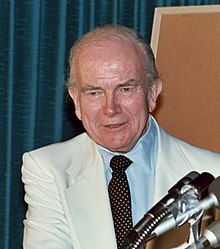Milton Canif
Milton Caniff is an American cartoonist, born in Hillsboro, Ohio, in 1907 and died in New York on April 3, 1988.
Biography
Childhood and youth
The son of a printer, he used to take his son to the newsroom since he was little. At the age of nine he moved with his parents to California and they settled very close to Hollywood; he even got to play a movie extra. From 1922 he published the first illustrations of him and would meet Noel Sickles in 1925 (known above all as & # 34; Scorchy Smith & # 34;, a cartoonist who would influence him later), when he was studying at Ohio University for get a degree in Fine Arts.
Professional career
During the Great Depression, Caniff and Sickles opened an art agency in Columbus, but it didn't take off and they had to close. Then he had to emigrate to New York in 1932. In an electoral campaign he came to draw the portraits of thirty-five candidates, although only Franklin D. Roosevelt would be published.
He launched into humorous drawing, creating "Puffy the pig" and "The Gay Thirties", but it wasn't until 1933 that he created his first famous work, "Dickie Dare". The protagonist is a twelve-year-old boy who is passionate about reading, and with an overflowing imagination. Thus, together with his dog Wags from him, he gets involved in the adventures that he discovers in his readings. A year later he was hired by the Chicago Tribune and will launch what will undoubtedly be his most famous series and an essential read: "Terry and the Pirates". The series owes its name to the fact that its protagonist, Terry Lee, accompanied by his inseparable friend, Pat Ryan, are kidnapped, on a trip along the Chinese coast, by pirates commanded by one of the best-known villains of the series, the Dragon Lady. The series was a great success, and this led to the fact that in 1942 the Camp Newspaper Service, specialized in military publications, commissioned him to carry out a series to raise the morale of military troops in World War II. Caniff responded by making some strips starring the blonde Bulma, who already appeared in Terry's series mentioned above.
However, the Tribune News Syndicate, which owned Terry and the Pirates, did not take kindly to this adaptation. As a consequence, Caniff created a new series "Male Call", which debuted in 1943. Among the girls who appeared in the series, Miss Lace stood out and was published until 1946. In January 1947 he created "Steve Canyon", starring an ace of the North American aviation that, once demobilized, founded an aviation company, “Horizons Unlimited”. Canyon accepts the most risky missions and fights against the most bloodthirsty individuals, spending his adventures mainly in the countries of Southeast Asia or the Middle East. The logo for the series was created by his friend Sickles, who had already collaborated with him on Terry.
Assessment and influence
Caniff was dubbed “the Rembrandt of comics” for his technical mastery. He was a master of black and white and his light and shadow play has influenced many authors. In other countries, such as Spain, his work did not create a school until many years later, being preferred in the postwar period as references to Flash Gordon, Jorge and Fernando and The Phantom.
Although in his first works (Puffy the pig, The Gay Thirteies, Dickie Dare) he did not show the refinement that he would obtain later, it is in “Terry and the pirates” where a remarkable evolution can be appreciated. In the first strips and Sunday pages, the humorous heritage can still be appreciated, but soon his lines become more realistic and detailed. It is also noteworthy his depiction of the female figure, with some impressive women, worthy of the "pin-up". In “Male Call” he allowed himself greater graphic freedom than in Terry, and he put a special effort into its realization. In "Steve Canyon" we see a completely mature Caniff, and it is the series that he carried out until his death, in 1988.
Caniff adopted many resources from the new language of cinema, the American shot and imitations of the shot-sequence, but, what is more important, he definitively substituted the episodic for the continuity series, being the challenge of suspense at the end of the strip or Fundamental page to maintain the climax. And he took this logic to the extreme: the daily strips were connected to each other and to the Sunday one, but also the series could be read only with the Sunday pages, or also only with the daily ones: a feat mandated by his editorial syndicate. In this way, the instinct of repetition characteristic of the first period (we could say Fordist) was replaced by narrative continuity as a new policy whose final objective was none other than to retain readers. And it is that Caniff always saw himself as a worker whose main job was to help sell copies of the newspapers where his strips were published.
Work
- Terry and the pirates (1934 - 1946)
- Male Call (Call to the male11 October 1942 - 3 March 1946)
- Steve Canyon (13 January 1947 -?). (He continued until shortly before his death.)
Contenido relacionado
Cesar Milstein
Michael mihura
Family tree
